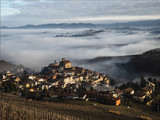
It is early on a very cold morning in January, Walking down the street I reach a viewpoint where I catch a glimpse of the majestic Alps and the rolling fog slowly creeping through the hills, then and there it hit me….I made it to Barolo!
Barolo is a commune in the province of Cuneo, Piedmont in northwest Italy. It is also the name of the most famous region in the world dedicated to the exquisitely fragrant and extremely tannic Nebbiolo grape. The region was one of the first to be granted DOCG (Denominazione di Origine Controllata e Garantita) status in 1980, together with Brunello di Montalcino and Vino Nobile de Montepulciano.
The historical significance of the regions is impressive. In the mid-1800s the Risorgimento (movement for Italian political unification) started in the region, in fact Victor Emmanuel II (Vittorio Emanuele,) who was originally king of Piedmont became modern Italy’s first king in 1861, and Turin served as the first capital of a united Italy. There are many heroes from that time (mid 19th century) in Barolo including Francesco Staglieno, who made the first dry Barolo; Camilo Benos (Conte di Cabour,) for his patronage of Staglieno; King Vittorio Emmanuele himself and his Fontanafredda estate popularizing and maintaining Barolo production.
For most of the 20th century the region remained quite primitive and rural. The producers faced hard times as the country was coming out of the two world wars. The younger generations had fled to Turin to work at Fiat and other factories, leaving behind the struggles of agricultural work and rural life. Even the most renown producers were selling very little wine outside the region and bottling on demand. Clear proof of this is the fact that until the 1970’s we can find the same vintage in different bottle shapes (some very interesting) and even with different labels.
In the late 1970s and early 1980s a group of young, revolutionary winemakers were inspired by their counterparts in Burgundy. They started improving viticulture and winemaking practices; and that’s how the ‘Barolo Boys’ and their ‘Modernista’ style came to the forefront. This movement started using new oak, shorter macerations, making wines with a fruitier character and more approachability in youth, and just like that a battle with the ‘Classic’ producers had begun. Taken to the extreme and combining political connotations, Bartolo Mascarello launched the 1998 vintage under the ‘No barrique, No Berlusconi’ label.
Today the difference between modernista and classic producers are not that clear, especially because most of the moderstinas have come closer to a more classical approach in winemaking. I must admit that I am a lover of the Classic style in the region (with ageing in large, old Salvonian oak bottis and very long post fermentation macerations) these wines require more patience and take considerable ageing in bottle to round out the intense tannins. I also must admit that the revolution was very much needed to shake off the region as a whole and has done wonders to promote the fantastic wines from here.
Barolo DOCG consists of 11 communes, but the core in terms of quality is concentrated in five of those: Barolo itself, Castiglione Falleto, Serralunga d’Alba, La Morra and Monforte d’Alba. The communes each have vineyards with contribute their own unique styles, this was solidified in 2010 when the region recognized the MGAs (Menzione Geografica Aggiuntiva) or Crus. These ‘Crus’ refer for the most part to a conglomerate of vineyards with a similar style, but there’s not the quality hierarchy that we can find for instance in Burgundy. That said, some Crus are regarded and highly sought after for their quality.
There are two main soil types in the region, both associated with a particular expression of Nebbiolo. The Tortonian soils (with higher content of clay and magnesium) of La Morra and Barolo usually gives more elegant and perfumed wines, while the Serravilian soils (with higher content of sand, limestone and iron) of Serralunga d’Alba and Monforte d’Alba are usually associated with more powerful and austere wines. But of course, as with every rule, there are exceptions.
These are wines with a very long history but a rather recent commercial success, they require your patience, but once they reach maturity, they can be one of the most ethereal, expressive and most memorable wine experiences. Chek out what we have available.
